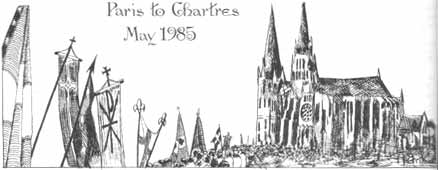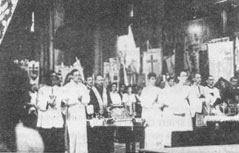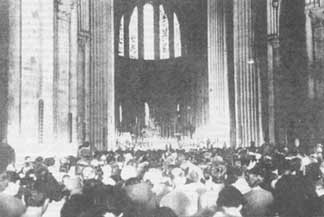The Pentecost Pilgrimage Paris to Chartres May 1985

|
One of the most encouraging events since the imposition of the New Mass took place in France at Pentecost this year. It took the form of a pilgrimage from the Cathedral of Notre Dame in Paris to the Cathedral of Notre Dame in Chartres. It was organized by the Centre Charlier, a French traditionalist movement independent of the Society of St. Pius X, but warmly supported by the priests of the Society, many of whom took part in the Pilgrimage. This pilgrimage has taken place for a number of years, but at its conclusion Mass had to be celebrated in the cathedral square, as the doors were closed to those wishing to take part in the Tridentine Mass, the most awe-inspiring act of worship ever to develop within the Church under the guidance of the Holy Ghost. This year, not only were the pilgrims made welcome, and a Solemn High Tridentine Mass celebrated, but warm messages of welcome were read from His Holiness Pope John Paul II and Cardinal Gagnon. The number of pilgrims had grown along the way and 10,000 of them filed into the cathedral for the concluding Mass; far more are expected next year. This is surely one of the most positive results of the October 1984 Indult. The account which follows has been written especially for us by a member of the Young Roman Catholics, a traditional movement of young people in Great Britain. The drawing above is by Ivan Grimer, another member of the Y.R.C., and the photographs appeared in the French daily Present. We hope that at Pentecost next year some young readers of The Angelus will wish to take part in the Pilgrimage! |
OPPONENTS OF THE TRADITIONALIST movement are finding it increasingly difficult to brand it as schismatic or disobedient. The third annual Pèlerinage de Chretienté, organized by the Centre Charlier in Paris, took place at Pentecost this year, and was given open encouragement from Rome. The Holy Father sent his blessing, and Cardinal Gagnon, President of the Pontifical Council for the Family, sent his warmest wishes to the pilgrims who were praying this year especially for the Family, Future of Christianity.
Saturday, Vigil of Pentecost: Paris
The pilgrimage began on Saturday, the 25th of May, with an early morning service in the Cathedral of Notre Dame, Paris. Abbé François Pozzetto, the chaplain to the Centre Charlier—which has as its aim the spiritual, cultural and moral regeneration of France—read out the blessing from the Pope: "His Holiness John Paul II imparts his Apostolic Benediction to the faithful of the great 'Pilgrimage of Christianity' organized by the Centre Henri et Andre Charlier at Pentecost 1985, invoking an abundance of divine graces upon them." Unfortunately, Cardinal Lustiger would not allow a Tridentine Mass to be celebrated for the pilgrims in his cathedral. Nevertheless, there was no place for bitterness or resentment on this pilgrimage: in the Veni Creator that morning we sang Accende lumen sensibus, Infunde amorem cordibus, and the Holy Ghost heard our prayer. A spirit of charity reigned throughout the three days, and all shared a firm trust that, after all, Our Lady of Chartres would grant her children a special favor at the end of the road . . .
After the service the pilgrims filed out of the cathedral in their various chapitres and équipes, each with its own banner honoring a particular saint and often evoking the crusading, feudal, and royal traditions of France, "Fille ainée de l'Eglise." The procession was indeed medieval in its blaze of color. Particularly well represented, judging from the vast number of its banners, was the MJCF (French Catholic Youth Movement), founded in 1968. Since then it has produced nearly one hundred priests and religious vocations for the Church. The Scouts Catholiques de France were impressive too with their military discipline and distinctive uniforms. They were to do a magnificent job as marshals along the route. The English-speaking contingent marched under the banner of the "Young Roman Catholics," the English traditionalist movement. For the first day we were allocated, appropriately enough, to the équipe of Normandy. The organizers must have decided later that we did not, after all, qualify as honorary Frenchmen, as we were soon relegated to an équipe étrangère with the Swiss. We were under the spiritual guidance of a Deacon from New Zealand, James Peek, who was ordained priest at Ecône in June. As Fr. Peek later wrote in The Catholic: "There reigned in our chapter a spirit of intimacy and friendship from which we all benefited. One could say that the passage of grace was almost palpable." Our group was mostly English, but Scotland was represented, as was even the United States of America.
Parisians rising early must have been astonished at the sight of the seemingly endless line proceeding south up the Boulevard St. Michel past the churches of Saint-Julien-le-Pauvre, Saint Germain, Sainte-Genevieve—now their Pantheon—and, not far away, our Saint Nicholas du Chardonnet. From the heights of a long but gentle incline, we could watch many thousands of our fellow pilgrims pouring uphill from the Ile de la Cité. It was a magnificent sight. The cold and the light mist of the early morning had already given way, as the clear sky had promised, to an intensely hot sun, welcome now, but to be bitterly regretted by the afternoon.
Once out of Paris and off the main roads, the initial euphoria died down, and the singing of the Rosary was taken up. Decade upon decade was sung (in French) during the three days; meditations, too, were preached at regular intervals. The route, meanwhile, became more interesting: through woods, along the fields and down the narrow, winding lanes of the Ile-de-France. It was in the wood at Verrières, at the Carrefour de l'Obélisque, that the Mass we had been denied in Paris was celebrated. But if Archbishop Lustiger was unfavorable toward us then nature compensated by providing us with a spacious temple in this clearing. By the time we arrived, the altar with its canopy had already been set up, and equipment was being unloaded from a van marked "Liturgie." This included an organ and a P.A. system. The Missa Cantata of the Vigil of Pentecost was celebrated by Abbé Laffargue, and the sermon was preached by Abbé du Chalard. The Mass was followed by a lunch of bread and wine—the pilgrims' staple diet.
The afternoon was truly penitential. I reflected that at ten o'clock that morning it had already been warmer than a fine English afternoon in July; by two o'clock the scorching heat was claiming victims. Although we were provided with sugar cubes, some simply could not stand the pace and the heat. The Red Cross were busy. We passed some unfortunate young cleric receiving attention, face down in the grass by the side of the road. By the time we arrived at the camp, called le Domaine d'Ecosse, at the end of the day, we had covered twenty-five miles and quite a few people were hobbling badly with blisters. It was now that the superbly efficient logistic organization of Max Champoiseau and his team became apparent. The lower end of the field was covered with large marquee tents, and portable latrines and washing facilities had been installed. All our baggage had been ferried from Paris by truck and arranged, according to équipe, on one side of the field. The altar with its canopy was already set up, and 1,000 litres of hot soup was awaiting us. At the campfire later on that evening the founder of the Centre Charlier, Romain Marie, addressed the pilgrims and introduced them to Ramsi Namour, a representative of the Lebanese Christian Forces, for whom there was a long ovation. After night prayers we found our way back to our tents by the light of the fire and slept as best we could through a chilly night.
Sunday: Pentecost
Et ecce gloria Dei Israel ingrediebatur per viam orientalem: And behold the glory of the God of Israel came in by way of the East. The rising sun cast a magnificent glow over the Domaine d'Ecosse as the High Mass of Pentecost was celebrated early next morning by Father Franz Schmidberger, Superior General of the Society of St. Pius X. Priest, deacon and sub-deacon performed the sacred drama with a wonderful dignity and precision. The choir sang the Veni Creator and Ubi Caritas et Amor beautifully. All present, clergy and people, gave of their best in the offering of the Mass. Hearts and minds were raised to God by the incomparable beauty of the Roman liturgy. Father Schmidberger preached an inspiring sermon, urging young Catholics to go out to others with greater apostolic zeal, and to establish the Kingship of Christ in society.
Spiritually fortified, the pilgrims ate a breakfast of bread, jam, and hot chocolate, in preparation for the grueling thirty miles ahead. The équipes were marshaled into order and we took the road again, across the exposed terrain and under a blazing sun. At some places, where the trees were fewer, we could see the column, clearly visible with its fluttering banners and oriflammes, stretching far out in front and behind. It was an inspiration to all since it was easy to forget, while walking with a chapter of fifty or sixty, the enormous length of the procession. The sleepy villages and hamlets through which we passed under the eyes of the curious inhabitants would have to endure an hour or so of trampling feet and Ave Marias.
On this day young Benedictine monks of LeBarroux and Dominicans of Avrille were much in evidence along the marching column with their traditional tonsures and habits. They were a source of encouragement and a striking testimony of the miraculous growth and success of the traditional religious communities in France.
The thirty miles covered on Pentecost Sunday were rewarded before the day was out with the awesome sight of our destination, the spires of the Cathedral of Notre Dame of Chartres, faintly visible on the horizon, over fifteen miles away through the haze. It made the last few miles to Gallardon bearable. The camp, when we arrived, was a hive of activity; the pilgrimage was like a whole town on the march and seemed to engulf the villages and towns it passed through. Everywhere in evidence were the young priests of the Society of St. Pius X, giving encouragement and sharing in the laughter and merriment of the various youth groups.

The pilgrims approach their destination . . . the magnificent spires of Chartres in the distance.
That night the pilgrims were addressed by Abbé Tournyol du Clos who raised their thoughts from their blisters and temporary discomforts to the things of eternity with the timeless lines of Péguy, begging Our Lady the strength to keep the commandments with "une fidelité plus forte que la mort." The French pilgrims, in response, sang the hauntingly beautiful song of the Vendée martyrs, butchered for their own unshakeable fidelity to the Catholic Faith.
Monday: Chartres
After an unexpectedly wet night during which a number of unfortunate pilgrims (the English-speaking chapter included), risking the open air because of lack of space in the tents, got a thorough soaking, we all set out again in the fine drizzle in high spirits, knowing that today's fifteen miles would bring us to the very steps of the Cathedral. When the spires came once more into view, all fell to their knees to sing the Salve Regina in thanksgiving, as Péguy had done before them. Our thanks were all the more fervent because we had received confirmation that we had been granted what Belloc had once called the supreme moment of the Christian ages: High Mass in a medieval cathedral. For the last two years Mass had been celebrated on the steps of the church, but this year the Bishop of Chartres had graciously granted our request under the Indult. It was to our Holy Father, however, that our gratitude was chiefly felt, since it had been through his personal intervention that the Old Mass had once again become part of the Church's official worship.
With the vision of those famous asymmetrical spires constantly before our eyes, our progress seemed painfully slow. However, having been marshaled on the outskirts of the city, we finally made our entry, six abreast and tightly packed. We surged through the narrow streets, thousands of parched throats singing the Ave Marias with more than usual enthusiasm. The weather had improved dramatically and by the time we emerged onto the cathedral square, the west front stood out brilliantly in the sun against a deep blue sky.

Father Groche, Dom Gerard, Father Schmidberger, Father Simoulin (Rector of the St. Pius X University in Paris), Father Aulagnier (Superior of the District of France), and Father Tournyol du Clos (the Dominicans of Avrille), in the Cathedral of Our Lady of Chartres.
It took nearly an hour for the 10,000 of us to fill the cathedral to overflowing. With all the banners of all the chapters and équipes proudly displayed around the choir and apse, the Solemn High Mass of the Monday of Pentecost was celebrated by Abbé Lecarreux, the founder of the Community of the Transfiguration. For the first time in thirteen years, the Missal of St. Pius V was used in this Cathedral, and, with the magnificent Gregorian Chant accompanying it, this Mass would have been quite recognizable to the faithful Christians who worshipped in this place over 1,000 years ago. The continuity and timelessness of our Religion was stressed by Dom Gerard of LeBarroux in his sermon: "Here you are, gathered together by God's grace within the walls of this blessed cathedral under the gaze of Our Lady in the great stained glass window; one of the most beautiful depictions of the Holy Virgin, before which we know St. Louis once came to kneel." Later, at the elevation of the Body and Blood of Our Lord, the banners dipped in homage. A stark contrast to the awesome silence of the consecration was the magnificent and thunderous Te Deum at the end of the Mass, which truly expressed the gratitude and faith of all the thousands present.

". . . the supreme moment of the Christian ages: High Mass in a medieval cathedral . . ."
The average age of the pilgrims must have been about twenty. Our elders, therefore, need have no worry for the future of the Church. A journalist from the French newspaper Présent records these impressions of the pilgrimage: "Dynamism, youth, prayer, a supernatural hope which revives; a freshening of the soul which comes, through the ever-new ideas of the Eternal Church, to renew the old nation." The message should be clear enough to those who would transform the Church Militant into the Talking Church, and who would make Christianity comfortable and acceptable to "Modern Man": young people will rise to a challenge, to the Church's eternal truths, and will take up her weapons of sacrifice, prayer, and asceticism. "When Christianity," says G.K. Chesterton, "comes to terms with the world, it will be the end of Christianity."
Paul Dorey,
Student of Mediaeval History,
St. Andrews University, Scotland
